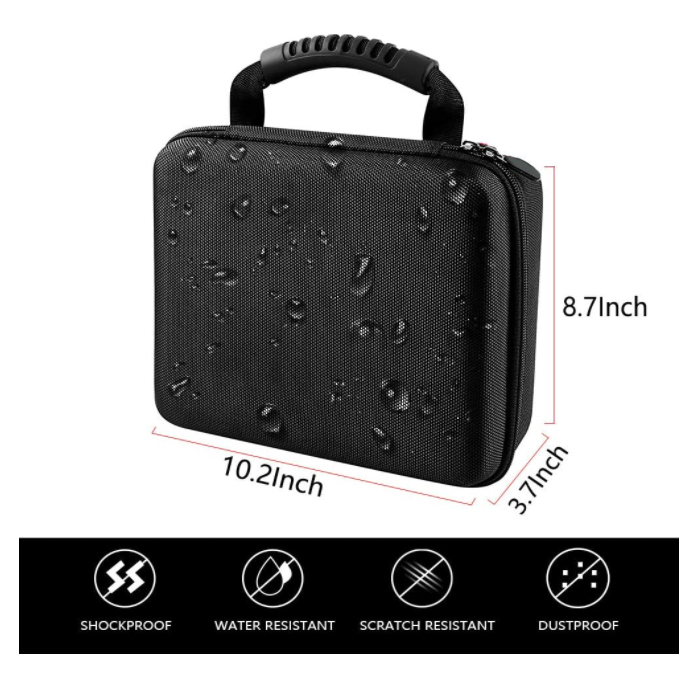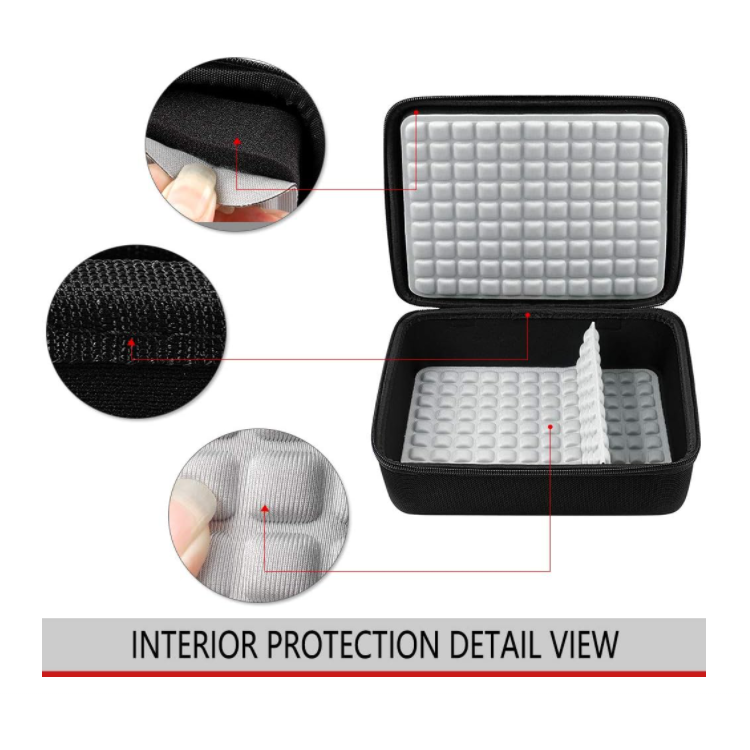Förståelse av slitstyrkekonkurrensen: EVA kontra tygmaterial för fodral
När det gäller att skydda våra värdefulla föremål spelar valet av väskmateriel en avgörande roll för att säkerställa långsiktig hållbarhet och säkerhet. Eva Cases har framträtt som ett populärt alternativ till traditionella tygväskor och erbjuder unika skyddsegenskaper som fångat konsumenternas intresse inom olika branscher. Denna omfattande analys undersöker de distinkta egenskaperna hos båda materialen och hjälper dig att fatta ett välgrundat beslut för dina förvaringsbehov.
Vetenskapen bakom EVA-väskornas konstruktion
Materialens sammansättning och egenskaper
EVA-väskor tillverkas med eten-vinylacetat, en mycket slitstark kopolymer som kombinerar flexibilitet med motståndskraft. Detta material har en unik molekylär struktur som ger utmärkt stötdämpning samtidigt som det behåller sin form under påfrestande förhållanden. Konstruktionen med sluten cellskum skapar en vattentät barriär som förhindrar fuktpenetration, vilket gör EVA-väskor särskilt lämpliga för att skydda känslig utrustning.
Tillverkningsprocessen för EVA-höljen innebär precisionsformningstekniker som säkerställer konsekvent kvalitet och strukturell integritet. Materialets densitet kan anpassas för att uppfylla specifika skyddskrav, vilket resulterar i höljen med olika grad av styvhet och dämpning.
Strukturella fördelar med EVA
De inneboende egenskaperna hos EVA-materialet bidrar till överlägsen strukturell integritet i höljesdesign. Den formade konstruktionen skapar sömlösa kanter och hörn som tål slitage bättre än sydda tygalternativ. Denna enhetliga struktur eliminerar svaga punkter som ofta finns i tyghöljen, särskilt vid sömmar och fogar.
EVA-höljen behåller också sin form även under betydande yttre påfrestning, vilket ger konsekvent skydd för innehållet. Materialets formminnesegenskaper säkerställer att det återgår till sin ursprungliga form efter stötar och därmed bibehåller sin skyddsförmåga över tid.

Undersökning av tyghöljens egenskaper
Traditionella tygkonstruktionsmetoder
Tygfodral använder vanligtvis material som nylon, polyester eller duktyg, ofta förstärkta med inre dämpning eller strukturella stöd. Konstruktionen innebär skicklig sömnad och flera lager av material för att uppnå önskad skyddsnivå. Även om denna traditionella metod har fungerat väl för många ändamål, har den inneboende begränsningar när det gäller hållbarhet och skydd.
Beroendet av sydda sömmar skapar potentiella svaga punkter där upprepade belastningar kan leda till försämring. Även tygfodral av hög kvalitet kan visa tecken på slitage vid dessa fogar över tid, särskilt vid frekvent användning eller hårda förhållanden.
Faktorer som påverkar tygets prestanda
Prestandan hos tyghöljen beror till stor del på kvaliteten på de material som används och de tillverkningstekniker som tillämpas. Även om högpresterande tyghöljen kan erbjuda god skyddsnivå, kräver de ofta ytterligare vattentätande behandlingar och regelbunden underhåll för att behålla sina skyddsegenskaper. Materialets flexibilitet, även om den är praktisk för förvaring, kan ge otillräckligt skydd mot stötar och komprimering.
Vädertålighet fortsätter att vara en utmaning för tyghöljen, eftersom även behandlade material med tiden kan ge vika för fuktinträngning, vilket potentiellt kan äventyra innehållets säkerhet. De flesta tygers absorberande natur innebär också att de kan behålla lukt och bli brottsplatser för mögel i fuktiga förhållanden.
Jämförande hållbarhetsanalys
Slagmotstånd och skydd
EVA-höljen visar överlägsen slagstyrka jämfört med tygalternativ. Materialets förmåga att absorbera och sprida stötar hjälper till att förhindra skador på innehållet vid oavsiktliga fall eller påverkan. Tester har visat att EVA-höljen kan tåla avsevärt högre stötkrafter samtidigt som de behåller sin strukturella integritet.
Den enhetliga densiteten och konsekventa skyddsnivån som erbjuds av EVA-höljen ger tillförlitlig säkerhet för känsliga föremål. Till skillnad från tyghöljen, som kan ha varierande skyddsnivåer beroende på var stöten sker, erbjuder EVA-höljen omfattande skydd över hela ytan.
Miljömässig motståndskraft
När de utsätts för miljöpåfrestningar behåller EVA-höljen sina skyddsegenskaper effektivare än tyghöljen. Materialets motståndskraft mot vatten, damm och UV-strålning säkerställer långsiktig hållbarhet utan försämring av skyddsegenskaperna. Denna motståndskraft mot miljöpåverkan gör EVA-höljen särskilt lämpliga för utomhusanvändning och resor.
Den kemiska stabiliteten i EVA-material innebär också att dessa höljen är mindre benägna att försämras när de utsätts för vanliga ämnen som kan skada tyghöljen. Denna resistens mot kemisk försämring bidrar till en längre funktionslivslängd.
Långsiktiga värdeöverväganden
Underhållskrav
EVA-höljen kräver vanligtvis minimalt underhåll för att behålla sina skyddsegenskaper. Enkel rengöring med mild tvål och vatten räcker oftast för att hålla dem i optimalt skick. Den icke-porösa ytan förhindrar upptag av smuts och föroreningar, vilket gör regelbundet underhåll enkelt och effektivt.
I motsats till detta kräver tyghöljen ofta mer frekvent rengöring och kan behöva särskild vård för att behålla sitt utseende och skyddsegenskaper. Risken att tyget absorberar fläckar och håller kvar fukt kan leda till ökade underhållskostnader och större ansträngning över tid.
Kostnads-nyttoanalys
Även om EVA-fodral kan ha en högre initial kostnad jämfört med tygalternativ, innebär deras överlägsna slitstyrka och längre livslängd ofta bättre långsiktig värde. Mindre behov av utbyte och minimala underhållskrav bidrar till lägre totala ägandokostnader över tid.
Den konsekventa skyddsnivå som EVA-fodral erbjuder hjälper också till att bevara värdet på de föremål de skyddar, vilket potentiellt kan förhindra dyra skador eller ersättning av innehållet. Denna skyddande egenskap gör dem till en klok investering för värdefull utrustning och föremål.
Vanliga frågor
Hur länge håller EVA-fodral vanligtvis jämfört med tygfodral?
EVA-fodral håller i allmänhet betydligt längre än tygfodral och behåller ofta sina skyddande egenskaper i 5–7 år eller mer med ordentlig vård. Tygfodral visar ofta tecken på slitage inom 2–3 år av regelbunden användning, särskilt vid belastningspunkter och sömmar.
Kan EVA-fodral tåla extrema temperaturer?
EVA-fodral visar utmärkt temperaturmotstånd och behåller sin strukturella integritet i temperaturer från -20°C till 70°C. Denna termiska stabilitet överstiger de flesta tygfodrals, som kan försämras eller förlora formen vid extrema temperaturer.
Är EVA-fodral värda den högre initiala investeringen?
Den överlägsna hållbarheten, skyddet och livslängden för EVA-fodral motiverar vanligtvis deras högre startkostnad. När man tar hänsyn till den längre livslängden och minskade underhållsbehovet visar sig EVA-fodral ofta vara mer ekonomiska på lång sikt jämfört med att byta tygfodral oftare.
Hur fungerar EVA-fodral i blöta förhållanden?
EVA-fodral presterar utmärkt i blöta förhållanden tack vare sina vattentäta egenskaper och icke-absorberande natur. Till skillnad från tygfodral som kan bli vattenfyllda eller behöva tid att torka bibehåller EVA-fodral sina skyddande egenskaper oavsett väderförhållanden, vilket gör dem idealiska för utomhusanvändning.

